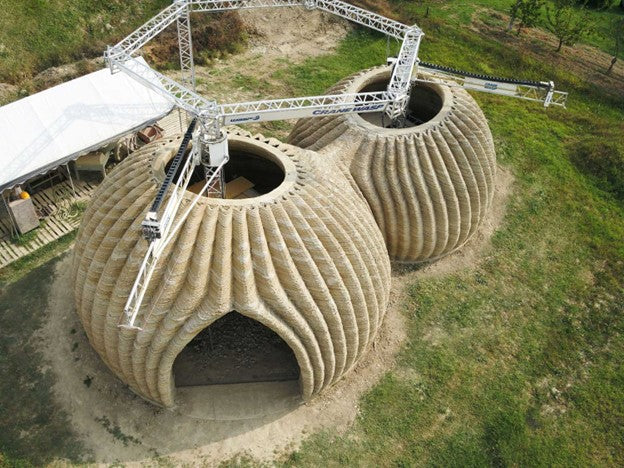How 3D Printing is Helping with Sustainable Construction

The construction industry is one of the largest contributors to global carbon emissions and material waste. However, the rise of 3D printing technology is helping to revolutionize this sector, bringing forth innovative solutions that promote sustainability. Through minimizing waste, utilizing eco-friendly materials, and optimizing construction processes, 3D printing is becoming a key player in the drive for greener building practices. Here's how 3D printing is transforming the construction industry and paving the way for a more sustainable future.
1. Reduction in Material Waste

Traditional construction methods often result in significant material waste due to inefficiencies and excess material usage. According to the National Association of Home Builders, about 40% of the waste in landfills comes from construction materials. In contrast, 3D printing minimizes waste by using only the necessary amount of material.
The precision layering techniques of 3D printing ensure that every layer is laid exactly where it’s needed. This reduces the need for excess cement, wood, or steel, and eliminates offcuts and scrap. With 3D printing, construction materials are utilized efficiently, resulting in much lower waste and a reduced environmental footprint.
2. Use of Eco-Friendly Materials
One of the major advantages of 3D printing is the ability to use eco-friendly and sustainable materials in construction. For example:
-
Recycled Concrete: Companies are developing 3D printing technologies that incorporate recycled concrete. This reduces the demand for virgin materials, while helping to repurpose waste that would otherwise end up in landfills.

-
Clay and Mud Composites: Locally sourced, natural materials such as clay and mud can be used in 3D printing, reducing transportation emissions and offering an affordable, sustainable building material alternative.

-
Bio-Based Filaments: In some experimental projects, 3D printing is being used to create biodegradable, bio-based structures using plant-based binders and polymers, offering a more sustainable option for construction.

3. Energy Efficiency and Reduced Carbon Footprint
Energy consumption is a key concern in construction, as large machinery and extensive labor contribute to significant carbon emissions. 3D printing in construction significantly reduces energy usage in a few ways:
-
Automated Construction: 3D printing automates many aspects of the construction process, minimizing the need for heavy machinery and reducing fuel consumption.

-
Optimized Designs: 3D printing allows architects to design buildings with optimized structures, reducing the need for artificial heating and cooling systems. These structures can incorporate insulation layers and designs that naturally maintain comfortable temperatures, further reducing energy consumption.

-
Solar and Smart Integration: 3D printing is being used to incorporate energy-efficient systems, such as solar panels, directly into buildings. Additionally, some 3D-printed homes are designed with smart features, which enhance energy conservation and self-sufficiency.

4. Faster and More Cost-Effective Housing Solutions

The demand for affordable housing is increasing globally, but traditional construction methods can be time-consuming and expensive. 3D printing is making it possible to build homes more quickly and at a fraction of the cost:
-
Affordable Housing: 3D-printed homes can be constructed for much less than traditional homes, making them an ideal solution for affordable housing projects. By reducing construction time and labor costs, 3D printing is helping make housing more accessible to people in need.

-
Disaster-Resilient Homes: 3D printing is also helping to address housing shortages in disaster-stricken areas. The technology allows for the quick creation of strong, weather-resistant homes that can be produced in a fraction of the time compared to traditional methods.
-
Reduction in Labor Costs: The automated nature of 3D printing means less manual labor is required, lowering overall costs for construction projects. This makes 3D-printed buildings not only environmentally friendly but also economically viable.
5. Innovations in Sustainable Architecture
Architects and engineers are constantly pushing the boundaries of what is possible with 3D printing in construction. Here are some ways that the technology is contributing to innovative, sustainable architecture:
-
Organic and Nature-Inspired Structures: 3D printing allows for the creation of organic, nature-inspired building designs that are highly energy-efficient. Curved and flowing designs, which were once difficult to achieve with traditional methods, optimize airflow and reduce the need for energy-intensive heating and cooling systems.

-
Self-Sustaining Buildings: Some 3D-printed buildings are being designed to be entirely self-sufficient, with systems for rainwater collection, energy generation, and waste management. These buildings have the potential to operate off-grid, reducing their environmental impact.

-
Urban Sustainability Projects: Cities around the world are exploring 3D printing for urban infrastructure projects. Examples include eco-friendly bridges, urban furniture, and green spaces. These projects help to improve the sustainability of urban environments while reducing material waste and energy consumption.

6. The Future of 3D Printing in Construction
As 3D printing technology continues to advance, its impact on the construction industry is only expected to grow. With the development of new materials, improved printer capabilities, and faster production times, 3D printing has the potential to revolutionize the way we build, making construction more sustainable, affordable, and efficient.

In the future, 3D printing could become the standard method of construction, particularly for projects where sustainability and cost-effectiveness are key priorities. By continuing to innovate and invest in green technologies, 3D printing will play a pivotal role in shaping the future of construction.
Conclusion
3D printing is offering significant benefits for sustainable construction, from reducing material waste to promoting the use of eco-friendly materials and energy-efficient designs. As the technology continues to evolve, it holds the potential to reshape the construction industry by making it more sustainable, cost-effective, and efficient. The rise of 3D printing in construction represents a major step forward in the global effort to reduce carbon footprints and create greener, more sustainable living spaces.








